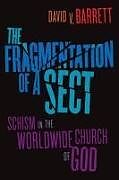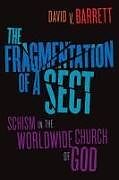Fragmentation of a Sect
Einband:
Kartonierter Einband (Kt)
EAN:
9780190492892
Untertitel:
Schism in the Worldwide Church of God
Autor:
David V Barrett
Herausgeber:
Oxford University Press
Anzahl Seiten:
308
Erscheinungsdatum:
15.07.2016
ISBN:
0190492899
Informationen zum Autor David V. Barrett has been writing about new religions and esoteric movements for many years. He received his Ph.D. in Sociology of Religion from the London School of Economics. Klappentext In the mid-1930s Herbert W. Armstrong, an unsuccessful American advertising executive, founded a millennialist Sabbatarian Christian sect with a heterodox theology. Over the next half century, despite a number of setbacks, scandals, criticisms, and attacks from former members and anti-cultists, Armstrong's organization, the Worldwide Church of God, grew to around 100,000 baptized members with a world circulation of over six million for its flagship monthly magazine Plain Truth. In January 1986, Armstrong died. His successor changed most of the church's distinctive doctrines, leading it towards an increasing convergence with mainstream Evangelical Christianity. This created a massive cognitive dissonance in ministers and members: should they accept or reject the authority of the church leadership which had abandoned the authority of the founder's teachings? Groups of ministers left the religion to form new churches, taking tens of thousands of members with them. These schismatic churches in turn faced continuing schism, resulting in over 400 offshoot churches within little more than a decade. Zusammenfassung Religions frequently face a period of turmoil and readjustment following the death of their founders. In this contribution to sociological theory, Barrett offers a new typological model for categorizing various outcomes, including schism and explores the usefulness of this model by applying it both to his case study the Worldwide Church of God and to a wide variety of other religions. Inhaltsverzeichnis Author's Note Acknowledgments Lists of photographs, tables and figures List of abbreviations 1. The Fragmentation of a Sect: an Introduction PART ONE: THE STORY 2. Doctrines of the Worldwide Church of God 3 Origins and History of the Worldwide Church of God 4. Schism and scandals in the Seventies 5. Revolution and Schism 6. Continuing Schism in the offshoots PART TWO: THE ANALYSIS 7. Authority in the Churches of God 8. After the Founder Dies - How movements change 9. Who went Where and Why 10. Fragmentation in a Sect - a Conclusion Appendices 1 Sect, cult, new religious movement 2 Theoretical basis and methodology 3 Literature and other sources 4 Church affiliation of respondents 5 Demographics of respondents 6 The future state of schism Bibliography ...
Autorentext
David V. Barrett has been writing about new religions and esoteric movements for many years. He received his Ph.D. in Sociology of Religion from the London School of Economics.
Klappentext
In the mid-1930s Herbert W. Armstrong, an unsuccessful American advertising executive, founded a millennialist Sabbatarian Christian sect with a heterodox theology. Over the next half century, despite a number of setbacks, scandals, criticisms, and attacks from former members and anti-cultists, Armstrong's organization, the Worldwide Church of God, grew to around 100,000 baptized members with a world circulation of over six million for its flagship monthly magazine Plain Truth. In January 1986, Armstrong died. His successor changed most of the church's distinctive doctrines, leading it towards an increasing convergence with mainstream Evangelical Christianity. This created a massive cognitive dissonance in ministers and members: should they accept or reject the authority of the church leadership which had abandoned the authority of the founder's teachings? Groups of ministers left the religion to form new churches, taking tens of thousands of members with them. These schismatic churches in turn faced continuing schism, resulting in over 400 offshoot churches within little more than a decade.
Zusammenfassung
Religions frequently face a period of turmoil and readjustment following the death of their founders. In this contribution to sociological theory, Barrett offers a new typological model for categorizing various outcomes, including schism and explores the usefulness of this model by applying it both to his case study the Worldwide Church of God and to a wide variety of other religions.
Inhalt
Author's Note
Acknowledgments
Lists of photographs, tables and figures
List of abbreviations
1. The Fragmentation of a Sect: an Introduction
PART ONE: THE STORY
2. Doctrines of the Worldwide Church of God
3 Origins and History of the Worldwide Church of God
4. Schism and scandals in the Seventies
5. Revolution and Schism
6. Continuing Schism in the offshoots
PART TWO: THE ANALYSIS
7. Authority in the Churches of God
8. After the Founder Dies - How movements change
9. Who went Where and Why
10. Fragmentation in a Sect - a Conclusion
Appendices
1 Sect, cult, new religious movement
2 Theoretical basis and methodology
3 Literature and other sources
4 Church affiliation of respondents
5 Demographics of respondents
6 The future state of schism
Bibliography

Leider konnten wir für diesen Artikel keine Preise ermitteln ...
billigbuch.ch sucht jetzt für Sie die besten Angebote ...
Die aktuellen Verkaufspreise von 6 Onlineshops werden in Realtime abgefragt.
Sie können das gewünschte Produkt anschliessend direkt beim Anbieter Ihrer Wahl bestellen.
Loading...
Die aktuellen Verkaufspreise von 6 Onlineshops werden in Realtime abgefragt.
Sie können das gewünschte Produkt anschliessend direkt beim Anbieter Ihrer Wahl bestellen.
| # | Onlineshop | Preis CHF | Versand CHF | Total CHF | ||
|---|---|---|---|---|---|---|
| 1 | Seller | 0.00 | 0.00 | 0.00 |
